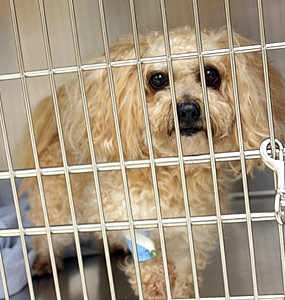Overview
Cirrhosis is chronic, end-stage liver disease in which normal liver tissue has been replaced by fibrous scar tissue. Your dog needs approximately 20% of normal liver function to survive. When cirrhosis occurs, scar tissue replaces functioning liver cells. If normal liver function falls below 20%, the disease becomes terminal. Cirrhosis can occur in dogs of any age, but is most common in middle-aged or older dogs. Some breeds such as cocker spaniels, Doberman pinschers, and Labrador retrievers are more commonly affected by it.
Cirrhosis occurs as a result of damage to the liver by many diseases, drugs, or toxins. Common diseases that may lead to cirrhosis include cancer as well as viral, bacterial, and fungal infections that cause hepatitis (inflammation of the liver). Certain toxins and long-term use of some medications, such as corticosteroids and common pain-relieving medications, can also cause cirrhosis. Therefore, it is crucial to have your dog’s liver function monitored when on certain medications.
 Symptoms
Symptoms
Symptoms will depend on the cause of the cirrhosis, and may include:
- Loss of appetite; weight loss
- Vomiting
- Diarrhea or constipation
- Lack of energy; depression
- Increased thirst; urination
- Swollen abdomen (fluid filled)
- Orange-tinged urine
- Yellow-tinged gums and whites of (sclera) or lining of the eyes (jaundice)
- Bleeding problems
- Behavior changes; seizures; pacing or circling
- Painful abdomen
Diagnosis/Treatment
Your veterinarian will take a complete history and perform a thorough physical exam of your pet. Additionally, diagnostic tests will be required to identify if your dog has liver cirrhosis. These may include:
- Chemistry tests to evaluate kidney, liver, and pancreatic function, as well as sugar levels
- Serologic tests to identify if your pet has been exposed to tick-related or other infectious diseases
- A complete blood count (CBC) to rule out blood-related conditions
- Electrolyte tests to ensure your pet isn’t dehydrated or suffering from an electrolyte imbalance
- Urine tests to screen for urinary tract infection and other disease
- A thyroid test to determine if the thyroid gland is producing too little thyroid hormone
- Abdominal and chest radiographs (x-rays) to evaluate the liver
- Abdominal ultrasound to evaluate the internal organs
- Coagulation profiles to assess your pet’s clotting function
- A liver biopsy
Treatment for your dog will vary depending on the underlying cause of the liver damage and cirrhosis. The good news is that treating the underlying cause of cirrhosis can, in many cases, stop the progression of the damage.
Treatment may include the following:
- Discontinuation of any therapy that may have caused the liver damage
- Intravenous fluid and electrolyte therapy, if your pet is dehydrated
- Blood products, if your pet is anemic
- Dietary modifications
- Medications, depending on the cause
Prevention
The prognosis for your dog depends on two factors: how much of the liver’s function is impaired and the ability to treat and control the underlying cause. The most effective prevention of cirrhosis is to address liver disease as early as possible and maintain your pet’s preventive health care to avoid any situation that may cause liver disease.
If you have any questions or concerns, you should always visit or call your veterinarian – they are your best resource to ensure the health and well-being of your pets.
